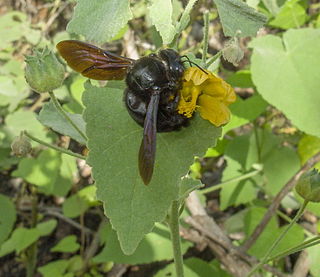
Organisms of many species are specialized into male and female varieties, each known as a sex. Sexual reproduction involves the combining and mixing of genetic traits: specialized cells known as gametes combine to form offspring that inherit traits from each parent. The gametes produced by an organism define its sex: males produce small gametes while females produce large gametes. Individual organisms which produce both male and female gametes are termed hermaphroditic. Gametes can be identical in form and function, but, in many cases, an asymmetry has evolved such that two different types of gametes (heterogametes) exist.

The brown-headed cowbird is a small obligate brood parasitic icterid native to temperate and subtropical North America. They are permanent residents in the southern parts of their range; northern birds migrate to the southern United States and Mexico in winter, returning to their summer habitat around March or April.

Papilio glaucus, the eastern tiger swallowtail, is a species of butterfly native to eastern North America. It is one of the most familiar butterflies in the eastern United States, where it is common in many different habitats. It flies from spring to fall, during which it produces two to three broods. Adults feed on the nectar of many species of flowers, mostly from those of the families Apocynaceae, Asteraceae, and Fabaceae. P. glaucus has a wingspan measuring 7.9 to 14 cm. The male is yellow with four black "tiger stripes" on each forewing. Females may be either yellow or black, making them dimorphic. The yellow morph is similar to the male, but with a conspicuous band of blue spots along the hindwing, while the dark morph is almost completely black.

Sexual differentiation is the process of development of the differences between males and females from an undifferentiated zygote. Appearance of Sertoli cells in males and granulosa cells in females can be thought of as the starting point for testicular or ovarian differentiation in many species.

A gynandromorph is an organism that contains both male and female characteristics. The term comes from the Greek γυνή (gynē), female, ἀνήρ (anēr), male, and μορφή (morphē), form, and is used mainly in the field of entomology. Notable gynandromorphic organisms are butterflies, moths and other insects, wherein both types of body part can be distinguished physically due to sexual dimorphism.

The bordered white or pine looper, is a moth of the family Geometridae. Among these, it belongs to tribe Bupalini of the subfamily Ennominae. B. piniaria is a common species throughout the western Palearctic region, the Near East and North Africa. However, its presence in certain regions – e.g. the northern Balkans – is doubtful.

Laothoe populi, the poplar hawk-moth, is a moth of the family Sphingidae. The species was first described by Carl Linnaeus in his 1758 10th edition of Systema Naturae. It is found throughout the Palearctic region and the Near East and is one of the most common members of the family in the region. It is distinctive due to its habit of resting with its hindwings held further forward than the forewings.

Birdwings are butterflies in the swallowtail family, that belong to the genera Trogonoptera, Troides, and Ornithoptera. Most recent authorities recognise 36 species, however, this is debated, and some authorities include additional genera. Birdwings are named for their exceptional size, angular wings, and birdlike flight. They are found across tropical Asia, mainland and archipelagic Southeast Asia, and Australasia.

Sauromalus ater is a species of lizard in the family Iguanidae. It inhabits the Sonoran and Mojave Deserts of the Southwestern United States and northwestern Mexico. Its range extends from eastern California, Utah, and Nevada south to Baja California and Sonora.

Carausius morosus is a species of Phasmatodea (phasmid) often kept as pets by schools and individuals. Culture stocks originate from a collection from Tamil Nadu, India. Like the majority of the Phasmatodea, C. morosus are nocturnal. Culture stocks are parthenogenetic females that can reproduce without mating. There are no reports of males, although in captivity, gynandromorphs are sometimes reared.

Ornithoptera victoriae, the Queen Victoria's birdwing, is a birdwing butterfly of the family Papilionidae, found in the Solomon Islands and Papua New Guinea.

Perdita is a large genus of small bees native to North America, particularly diverse in the desert regions of the United States and Mexico. There are 634 currently recognized species of Perdita, plus an additional 127 subspecies and many more species that remain undescribed. Perdita are usually quite small and often brightly colored with metallic reflections and/or yellow or white markings, and among the few lineages of bees incapable of stinging. The genus was extensively treated by P.H. Timberlake who, in addition to T.D.A. Cockerell, described most of the known species. Most species are extreme specialists (oligoleges) with respect to pollen and will only collect pollen from a few closely related species or genera of plants. Many species in this genus are called fairy bees.

In reproductive biology, a hermaphrodite is an organism that has complete or partial reproductive organs and produces gametes normally associated with both male and female sexes. Many taxonomic groups of animals do not have separate sexes. In these groups, hermaphroditism is a normal condition, enabling a form of sexual reproduction in which either partner can act as the "female" or "male". For example, the great majority of tunicates, pulmonate snails, opisthobranch snails, earthworms, and slugs are hermaphrodites. Hermaphroditism is also found in some fish species and to a lesser degree in other vertebrates. Most plants are also hermaphrodites.
Novopsocus magnus is a species of Pseudocaeciliidae that lives on the island of New Guinea. Males of this species were first thought by Thornton (1984) to be males of N. stenopterus, but Cuénoud (2008) showed that it is indeed a separate species by identifying real males of N. stenopterus and actual females of N. magnus. It is the largest species of the genus, and its males have peculiar antennae, with a first flagellar segment strongly broadened and flattened.
Novopsocus stenopterus is a Psocoptera species found in New Guinea. It is the type species of its genus, characterised by similar sexes, the males having antennae similar to those of females. There are two other species of Novopsocus.
Micrococcidae is a family of scale insects commonly known as the Mediterranean scales. There are two genera and eight species. Members of this family are found in Cyprus, Italy and other Mediterranean countries including Egypt, France, Greece, Israel, Lebanon, Libya, Syria and Turkey.

Stenopterini is a tribe of beetles in the subfamily Cerambycinae, containing the following genera:

Stenopterus is a genus of beetles belonging to the family Cerambycidae, subfamily Cerambycinae. Species of this genus are present in most of Europe, in the Near East and in North Africa.

Xylocopa darwini, the Galápagos carpenter bee, is one of only three species of bees found in the Galápagos Islands, to which it is endemic. This species is sexually dimorphic, is found on 75% of the largest islands, and is known for its complex behavior. As the only native bee, Xylocopa darwini serves as an important primary pollinator within the plant-pollinator network of the archipelago.
Harmaclona tephrantha is a moth of the family Tineidae first described by Edward Meyrick in 1916.
















